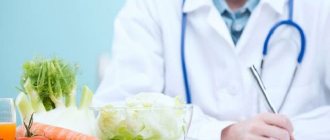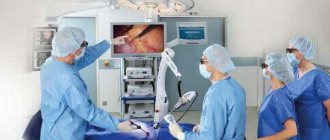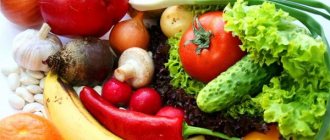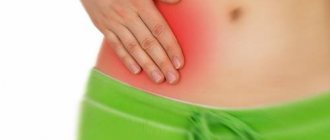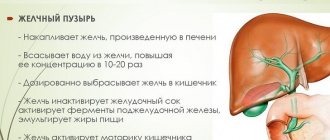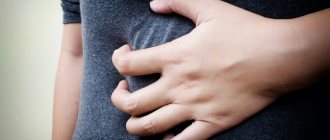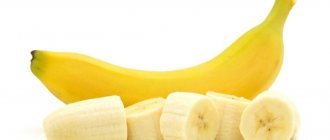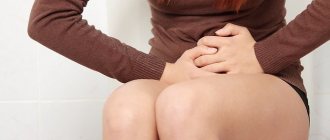There can be many reasons for gallbladder removal. Today, in medical practice, cholecystectomy is not some kind of extraordinary procedure. Most often, it is recommended in the presence of stones in the bladder, polyposis, cholesterosis and mechanical damage in this area, as a result of which the organ suffers. Complications are extremely rare after surgery. But after surgery, the patient will have to adhere to the prescribed diet throughout his life. It prevents bile from accumulating in the ducts.
Diet rules after gallbladder removal
The main rule in nutrition after cholecystectomy is to eat more often. This helps prevent the accumulation of bile in the bile ducts and, as a result, prevent the formation of stones.
You will have to eat at least 5 times throughout the day. It is best to have each meal at the same time. Food should be thoroughly chewed, and the portions themselves should be small.
Eating too hot or cold dishes is not allowed; everything is served warm. The patient’s main enemy is fried foods. You will have to avoid any foods that stimulate the production of bile and activate the digestive process.
It is necessary to maintain a drinking regime and drink at least 1.5 liters per day.
In the first weeks after surgery, you should especially monitor your health. Under no circumstances is lifting weights allowed, no more than 3 kg. You cannot engage in sports or heavy physical labor. You will even have to give up sexual relations for 3-4 weeks. You will have to watch your stool especially carefully; it should be regular and always soft. And of course, you should follow a diet.
Basic diet rules
The main goals of the diet in the absence of a gallbladder are:
- Creation of maximum chemical protection for the liver.
- Normalization of bile secretion.
- Stabilization of the normal functioning of the liver, bile ducts and the entire digestive tract.
According to the order of the Ministry of Health of the Russian Federation No. 330, the diet in the absence of a gallbladder in preventive institutions corresponds to the basic principles of standard nutrition - this is treatment table No. 5. In accordance with some restrictions in treatment table No. 5, the diet must be physiologically balanced, that is, contain the required amount of minerals, vitamins and other substances.
Non-compliance with the diet, consequences
If you do not adhere to a proper diet and consume prohibited foods, then after some time, eating disorders will begin. The food will no longer be completely digested. For this reason, you will feel heaviness in the stomach, your stool will change, and even pain will appear.
Another and main danger is the appearance of stones in the bile ducts. And this again means long-term treatment and possibly a new operation. Therefore, it is still important to follow diet No. 5. It has a number of positive aspects. In particular, it allows you to normalize all metabolic processes in the body. To comply with it, you need inexpensive products that can be selected according to the season. The diet allows you to get the required amount of vitamins and micro-macroelements. On the other hand, it is quite difficult to find approved dishes in catering chains; sometimes it is difficult to have a snack on time. Restrictions may be difficult, but it is worth it to feel normal. Therefore, you should treat everything philosophically and not worry.
Diet principles
Adaptation of the gastrointestinal tract after removal of the gallbladder consists of restoring damaged tissue, normalizing intestinal motility, increasing the functionality of the biliary tract, and can last up to a year, during which it is necessary to follow a special therapeutic diet No. 5, aimed at:
- prevention of postoperative complications;
- normalization of the chemical composition of bile;
- restoration of intestinal microflora;
- prevention of diseases after cholecystectomy.
After removal of the gallbladder, you must adhere to the basic principles of the Table 5 diet, regardless of the recovery period and the permitted diet:
- eat 5-6 times a day to prevent the formation of stones in the extrahepatic ducts;
- the optimal portion should be no more than 150-200 grams;
- avoid too hot and cold foods and drinks;
- chew food thoroughly, as saliva contains digestive enzymes (lysozyme, mucin, amylase, maltase) necessary for the digestion and absorption of micro- and macroelements;
- products containing animal fats should be excluded from the diet;
- vegetables and fruits are allowed to be consumed only in cooked form;
- Fried foods are prohibited;
- Be sure to include foods with fiber in your diet (whole grain cereals, bran and vegetables), which helps normalize intestinal motility;
- consume a sufficient amount of easily digestible protein from the types of fish and meat allowed on the diet (200-300 grams per day);
- drink 2-2.5 liters of pure or mineral still water per day.
Rapid recovery of damage to the abdominal cavity after laparoscopic cholecystectomy is not an indication for stopping the diet, since poor diet and consumption of prohibited foods can contribute to the development of postcholecystectomy syndrome (nausea, heartburn, stomach pain, diarrhea).
Diet in hospital
Immediately after the operation, everything is prohibited for 5 hours, even water. Although people usually do not notice any desires regarding food, they rest after undergoing surgery.
After this, if the doctor allows, you can drink water, always without gas. It is drunk in small sips and in small quantities. You can drink no more than 500 ml per day.
The next day, it is already possible to switch to a normal drinking regime, but the requirements for water remain the same, it must be clean and without gas. If the patient wants to eat, then 12 hours after the end of the operation, food is allowed. It must be liquid, for example, kefir or light soup, or jelly.
After this, diet table No. 5 according to Pevzner is prescribed. While the patient is in a hospital setting, from day 3-4 he is allowed to eat pureed vegetables, boiled fish, reduced to a mushy state. Soups should also be served pureed.
From the 5th day, it is already allowed to eat bread and cookies, but uneaten and dried ones. And already from 6-7 days they begin to introduce ground porridge, sour cream, chicken meat, naturally in a ground form. If loose stools appear, kefir is removed from the diet.
During the first week after surgery, meals should be eaten at least 8-10 times throughout the day. Portions in volume should not exceed 100 g. Only by the end of the week, the number of meals is reduced to 6-8 times, and the portions accordingly increase by 2 times.
In the future, the doctor will give nutritional recommendations upon discharge, depending on the patient’s condition.
What diet to choose in the postoperative period
After surgery, the body needs time for rehabilitation - a special regime and diet that will contribute to the speedy healing of wounds and restoration of function.
Pay attention to the digestive system - do not overload with fat and carbohydrates. Changes have been created in the gastrointestinal tract that you need to adapt to and get used to.
A diet when removing a gallbladder with stones will help eliminate complications and establish a diet.
On the first day after surgery to remove gallstones, eating and drinking is prohibited. The first sip of water is acceptable after 12 hours. After 24 hours, low-fat kefir, jelly or tea without sugar are allowed: 1 serving = 100 g, no more than once every 3 hours.
The first food is introduced into the diet on the 3-4th day: liquid mashed potatoes, various pureed soups or steamed omelettes - 7-8 times a day, 200 grams each.
A week later, the patient is prescribed a special diet: “The Fifth Table”. If the patient has complications - 5A or 5B. Promotes bile flow.
Authorized Products
- berries – raspberries, strawberries, blackberries;
- fruits – apricot, banana, baked apple, pear;
- egg - no more than one per day;
- soup - vegetable broth with cereals;
- bread - stale, crackers, empty biscuit;
- meat – beef, rabbit, lamb, chicken breast;
- fish – flounder, hake, cod, pollock;
- fermented milk - fermented baked milk, low-fat kefir, yogurt, milk, cheese, cottage cheese, containing a small percentage of fat content;
- groceries – pasta, oatmeal, rice, buckwheat;
- oils – butter, olive, sunflower;
- juice – natural;
- dried fruits – dried apricots, raisins, prunes;
- sweets – marshmallows, marshmallows, marmalade.
Prohibited Products
During the diet after gallbladder removal, you cannot:
- sweets – all products containing sugar, cocoa, honey;
- greens – sorrel, spinach;
- fruits – citrus;
- mushrooms and legumes - any;
- meat - lamb, duck, goose, pork, bacon, lard;
- fish - salmon, trout, salmon;
- fried - any food;
- smoking - any;
- canned food - any;
- fermented milk products - milk, sour cream, cream, cheese, cottage cheese, containing a high percentage of fat content;
- spices - radish, radish, onion, garlic, spices, sauces;
- baked goods – baked goods, puff pastries, cookies;
- alcohol - any.
Diet in the first week after discharge from hospital
As a rule, after 7 days the patient is allowed to go home. The doctor gives instructions regarding nutrition. This is usually a difficult period; the body needs to adapt to new conditions and rebuild the digestive tract. Strict restrictions are still difficult to achieve.
All food is boiled or steamed. There should be no exceptions in this case. Lean varieties of meat and fish are allowed, always reduced to a mushy state. You can eat bread, but it's stale. Porridges should have a low-fat consistency. You should eat often, but in small portions. When introducing new products, well-being is carefully monitored.
If at least some product causes discomfort, then they refuse it, which means that the body is not yet able to accept it.
In the first month after surgery
In the first month after removal of the gallbladder, recovery processes are aimed at adapting the intestinal mucosa to the constant presence of bile. For this purpose, the 5a diet is prescribed, the principles of which include:
- consumption of liquid and semi-liquid dishes of 120-150 ml every 3-3.5 hours to reduce the load on the digestive organs;
- use of dietary methods of cooking (boiling, steaming, stewing);
- exclusion from the diet of raw vegetables and fruits, as well as fried foods, which lead to chemical irritation of the intestines and increased stress on the pancreas.
| What can you eat | What not to eat |
| Flour products | |
| Day-old wheat bread, crackers, biscuits | Fresh bread, other types of baked goods |
| Meat | |
| Lean meats, poultry and fish | Fatty meat, lard, sausages, canned fish and meat, caviar |
| Eggs | |
| Only squirrels | Yolks, fried |
| Dairy | |
| Low fat | Fat |
| Fats | |
| Butter (1 teaspoon per day) | All other types |
| Cereals | |
| All types of cereals | |
| Vegetables | |
| Zucchini, onions, potatoes, pumpkin, carrots, beets | Other |
| Fruits | |
| Sweet varieties | Sour, unripe |
| Beverages | |
| Tea, weak coffee with milk, sweet fruit juices, herbal infusions, berry compotes and jelly | Alcohol, carbonated drinks, strong coffee, salts from sour fruits |
Can I drink alcohol after gallbladder removal surgery?
After cholecystectomy, it is advisable to abstain from alcoholic beverages altogether. In any case, such a strict restriction should remain in effect for 1-3 years after the operation. It is during this period that the body gets used to living without a gallbladder, and the gastrointestinal tract is rebuilt.
Many people give up alcohol for life. This is due to the fact that after drinking strong drinks, many people experience indigestion and vomiting.
But our society is structured in such a way that all holidays are accompanied by alcohol. Therefore, if the body accepts alcohol, then a little is possible, but subject to the following rules:
- no surrogate;
- It is best to avoid carbonated strong drinks;
- It is not recommended to drink drinks with fusel oils and those that have undergone distillation, that is, it is better to avoid cognac, whiskey, and tequila;
- under no circumstances should you eat fatty or spicy foods;
- Mineral carbonated water and brine are prohibited for hangovers.
Removing the gallbladder is not a death sentence, but you will have to constantly monitor your diet and health.
Products prohibited for consumption when the bladder has been removed
Unfortunately, after removing the bubble, a person will have to face certain restrictions. The diet for cholecystectomy involves partial or complete exclusion of the following foods:
- hot dishes with strong meat broth;
- pork, lamb, beef and other refractory fats of natural origin;
- various sausages;
- any smoked meats, pickled vegetables and pickles;
- spices and hot spices;
- lamb and pork;
- confectionery;
- goose and duck meat;
- alcohol;
- canned products (except for canned fruit);
- mushrooms;
- radish, garlic, onion;
- jellied meat, aspic and dishes that have a low temperature: their consumption causes spasm of the bile ducts;
- legumes: they contain a significant amount of coarse fiber.
Of course, you don’t have to deprive yourself of completely delicious food. For example, in some cases, as a dessert, You can make sour cream by mixing the dough with low-fat sour cream, but without adding margarine or butter to it. From all the variety of recipes, you need to select those during the preparation of which a minimum of fatty additives .
Regarding the consumption of fresh vegetables and fruits, you need to listen to your body. One person, with his gallbladder removed, can eat melon, strawberries, apricots, cucumbers, tomatoes, watermelons without harming his well-being and health, while for another the same foods cause digestive upset.
List of approved products
After discharge, milk and vegetable fats are gradually introduced. They are useful because they promote maximum bile discharge. It is useful to consume butter (no more than 30 g throughout the day) and flaxseed oil.
You can eat fermented milk products, all kinds of cottage cheese dishes, you can add sour cream, but low-fat.
It is allowed to eat soft-boiled eggs or in the form of an omelet. You can eat fish no more than 2 times a week; it is better to give preference to sea fish. Suitable meats include boiled beef and chicken.
You can eat first courses, but in no case cooked in strong meat broths; everything should be as light as possible.
Bread will do, but it must be dried; you can use bran.
Be sure to include porridge in your diet, including pearl barley, oatmeal, buckwheat and rice.
You can eat almost all vegetables, pumpkin and carrots are especially useful. After surgery, it is recommended to consume turmeric, bay leaves and greens. Fruits can also be consumed, but not sour ones. It is very useful to eat melons and watermelons, they help remove toxins and prevent bile from stagnating.
Even some sweets are not prohibited. You can eat jam, honey, marmalade, jam and marshmallows. However, there should be very little of them in the diet. It is allowed to eat prunes and dried apricots.
Sample menu for a patient after surgery
The patient's diet should place minimal stress on the body. For breakfast, you can make rice porridge with milk. In this case, the cereal must be cooked for a sufficiently long time to obtain a sufficiently thick and viscous consistency. You can drink it with unsweetened fruit compote or herbal tea with honey.
For second breakfast, experts recommend taking baked apples. They can also be seasoned with nuts, chopped dried apricots and raisins. For lunch, prepare a light vegetable soup with the addition of vermicelli. For the second course we recommend mashed potatoes without oil, fresh cucumbers and a steamed cutlet. You can drink it with weak tea.
Steamed meat cutlets are an important menu item
An afternoon snack may consist of berry or fruit jelly, yogurt. Dinner should be light. You can eat a vegetable salad with cabbage and cucumbers, as well as minced chicken cutlets. You need to have dinner at least four hours before bedtime. If hunger makes itself felt and this greatly worries the patient, you can drink a small glass of milk or kefir.
Healthy afternoon snack - yogurt
The next day the menu needs to be changed. For lunch, you can give the patient rassolnik with buckwheat porridge (boiled) and a piece of boiled chicken fillet. For dinner - sweet rice porridge with dried fruits and honey. Such nutrition is gentle and healthy, which is very important for a patient with a removed bladder.
Compliance with a selected diet is an important element of therapy and rehabilitation. Therefore, a sick person must understand the importance of such an event. Helpful video for more information:
List of prohibited products
Fatty foods are especially prohibited. You should not eat offal or rich broths. Mushrooms and any hot sauces and seasonings are prohibited. Spicy herbs are allowed, but in extremely limited quantities, best as a decoration for dishes.
Ice cream and any sweets, pastries, and cakes are completely prohibited. Prohibited:
- legumes;
- nuts;
- any cheeses;
- citrus;
- any smoked dishes;
- whole wheat bread;
- salo;
- radishes and radishes;
- margarine;
- pickles;
- persimmon;
- onions and garlic, especially fresh, but you can add them to dishes after heat treatment, but in small quantities;
- animal fats;
- grape;
- canned food
Under no circumstances should you eat fast food; cocoa and chocolate are prohibited. You'll have to forget about kvass, carbonated drinks and alcohol.
After about 12 months, prohibited foods are gradually introduced. Although it all depends on the state of health. If at least some product provokes deterioration, then it must be abandoned.
Diet for removed gallbladder
During cholecystectomy, treatment table No. 5a is prescribed on the 8th day. This is a strict diet, the purpose of which is to restore liver function, reduce inflammation, and improve digestion. You must adhere to its rules for 1-2 months.
Then, depending on the presence or absence of complications, the doctor prescribes one of the 5 types of diet:
- Diet No. 5 – a complete diet, recommended at the recovery stage;
- diet 5 - a gentle diet, recommended for acute pancreatitis, duodenitis that occurs due to removal of the gallbladder;
- table No. 5 l/f – a lipotropic-fat diet is prescribed for hypomotor dyskinesia.
Basic option
The standard diet after surgery to remove the gallbladder is distinguished by a set of foods with a normal content of proteins, slow carbohydrates and a minimum set of refractory fats. Culinary food processing - boiling, stewing, steaming, baking without oil. It is better to grind vegetables with coarse fiber and meat with veins.
Basic set of products for diet No. 5:
- slightly stale rye or wheat bread made from second-grade flour;
- lean meat, fish, poultry without skin;
- dairy, vegetable or non-rich meat soups;
- low-fat dairy products, mild cheese;
- limited amounts of butter and vegetable oil;
- any porridges and cereals, well cooked;
- 1 egg per day;
- non-acidic fruits, berries;
- vegetables that do not contain oxalic acid.
The following must be completely excluded from the menu:
- animal fats – lard, lard, lamb or beef fat, margarine;
- fatty dairy products - cream, sour cream, salted cheese;
- strong mushroom, meat, fish broths;
- canned food, marinades, pickles, smoked foods;
- fast food, semi-finished products;
- legumes;
- sausages;
- fatty fish, meat, poultry;
- some vegetables - spinach, radish, radish, sorrel, garlic, mushrooms, green onions;
- sour berries, fruits;
- ice cream;
- chocolate;
- drinks – coffee, cocoa, alcohol.
Gentle
A diet with limited calories (1900-2100 kcal), normal protein content, reduced fat and easily digestible carbohydrates. The purpose of nutrition is to minimize the process of bile secretion and protect the stomach and liver from the irritating effects of bile.
The diet is prescribed for a period of 14-21 days. All dishes are served in liquid or semi-liquid form. Meat and vegetables must be ground through a sieve several times. The consumption of cold or hot drinks, snacks, and main courses is prohibited. The menu should not contain:
- fatty meat, fish;
- mushrooms;
- rich broths;
- fresh bread;
- sweet desserts;
- raw vegetables, fruits.
Lipotropic fat diet
The main goal of the 5 l/f table is to improve the outflow of bile and normalize lipid metabolism. The basic diet is changing towards eliminating simple carbohydrates, increasing the amount of fats and polyunsaturated fatty acids. Basic rules of the lipotropic fat diet:
- Dishes are steamed, baked, boiled. Frying is completely excluded.
- There is no need to chop or puree food before serving.
- Legumes, cabbage, turnips, radishes, confectionery, baked goods, hot seasonings, and pickles are completely excluded from the menu.
- The daily calorie intake is 2800-3100 kcal.
- Table salt is limited to 4-6 grams per day.
Article on the topic: Remedy for heartburn
Recipes for dishes according to the diet menu
Dozens of interesting dishes can be prepared from each product. Therefore, you should not worry about restrictions; it is better to take this time with culinary creativity. There are different dishes on the menu for a week for the diet after gallbladder removal, here are the recipes.
Stewed chicken in a jar
A very simple and quick way to cook poultry in its juice. It is captivating because you don’t need to follow the process. Nothing burns or runs away, the dish can be served with any side dishes.
Ingredients:
- chicken;
- 2-3 carrots;
- 2 onions;
- 2 cloves of garlic;
- salt.
Cooking:
- Garlic and onions should not be consumed. Therefore, you need to chop it coarsely so that you can easily remove it later.
- Cut the bird into portions and remove the skin.
- Place chicken and vegetables in a glass jar and lightly add salt to the layers. Place a metal sealing cap on top, but remove the rubber ring (seal).
- Place the jar of chicken in a cold oven, turn it on to 180, simmer for two hours.
In this way you can cook rabbit, beef, and any other (allowed) types of meat. If desired, layer with potatoes, pieces of zucchini or pumpkin.
Spaghetti with seafood and cheese
This dish is suitable not only for the diet after removal (laparoscopy) of the gallbladder, but also for the everyday table of other family members. A chic and very quick option even for a festive dinner. Spaghetti of any kind, cook according to instructions.
Ingredients:
- 300 g seafood;
- 130 ml low-fat cream or milk;
- 30 g cheese;
- salt, dill;
- 1 tsp. flour;
- spaghetti.
Cooking:
- If seafood is frozen, you need to let it thaw. What needs to be cleaned. Remove the shells and cut the food if necessary.
- Place the cream in a saucepan on the stove. Bring to a boil, lower the seafood, and simmer for two minutes.
- Mix flour and 30 ml of water, add to the dish, add a pinch of salt, stir and cook for another minute. It is important not to overdo it.
- Remove from heat, add dill. When serving, place the spaghetti on a flat dish, pour over the seafood sauce, and sprinkle with grated cheese.
According to this recipe, you can cook only shrimp or squid; similar dishes with mussels turn out great, but they need to be cooked in even less time.
Pumpkin soup
First courses can be very tasty and bright, here is an example of that. An amazing pumpkin soup that is quick and easy to cook in half an hour.
Ingredients:
- 500 g pumpkin;
- 2 potatoes;
- 1 carrot;
- salt;
- a little sour cream and cheese.
Cooking:
- Chop the vegetables, place them in a saucepan and add enough water to cover the food by 3 cm.
- Place on the fire and cook the vegetables until soft. If you are short on time, you can pour boiling water over the food. At the end add salt to the dish.
- Beat the vegetables until creamy.
- When serving, season the dietary dish with low-fat sour cream and sprinkle with grated unsalted cheese.
Other pureed soups for the diet are prepared in a similar way. Often, in addition to vegetables, the base is chicken broth along with pieces of poultry. If you chop them, you get a hearty dish.
